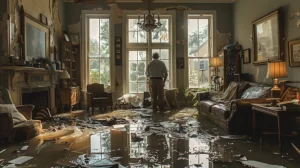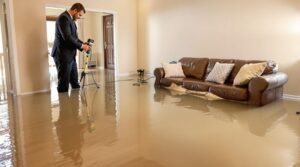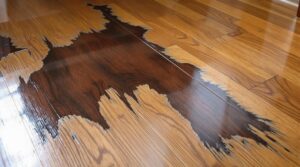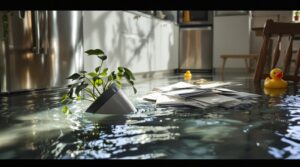Water damage in hardwood floors stems from multiple sources, including burst pipes, flooding, and excessive humidity. Common signs include warping, discoloration, and mold growth, requiring immediate professional intervention. Emergency response involves water extraction, thorough drying, and assessment of structural integrity. Repair costs range from $2-$20 per square foot, depending on damage severity and chosen restoration method. Insurance coverage varies by policy type and damage cause, making expert consultation essential for ideal outcomes. Addressing hardwood floor cupping causes is crucial for preventing further damage and ensuring the longevity of your flooring. Humidity imbalance, often exacerbated by water exposure, can lead to this specific issue, characterized by the edges of the planks rising higher than the center. To mitigate such problems, regular monitoring of moisture levels and prompt repairs are essential in maintaining the integrity and appearance of hardwood floors.
Key Takeaways
- Common causes include burst pipes, plumbing leaks, flooding, and high humidity levels that can penetrate wood flooring.
- Warning signs of water damage include warping, discoloration, cupping of boards, and mold growth between planks.
- Immediate response requires removing standing water, drying with dehumidifiers, and ensuring proper ventilation to prevent further damage.
- Basic refinishing costs range from $1,101 to $2,666, while complete replacements can exceed $15,000 depending on damage extent.
- Insurance typically covers sudden water damage from burst pipes but excludes flooding and long-term seepage problems.
Common Sources of Water Damage in Hardwood Floors
While hardwood floors add beauty and value to homes, they are susceptible to various forms of water damage that can compromise their structural integrity and appearance.
Primary sources include burst pipes, plumbing leaks, water spills, and natural disasters. Slow leaks and invisible water damage can lead to extensive deterioration before being noticed. Flooding and standing water pose significant risks, while humidity fluctuations can cause warping and structural changes in the wood.
Effective water damage prevention requires vigilant hardwood floor maintenance, including regular inspection of plumbing systems and prompt cleanup of spills.
High-risk areas benefit from protective measures such as moisture barriers and strategic placement of mats. In regions prone to flooding, implementing preventative strategies becomes essential.
Monitoring humidity levels and using moisture meters helps detect potential issues before severe damage occurs, while proper sealing during installation provides important protection against water infiltration.
Warning Signs Your Wood Floor Has Water Damage
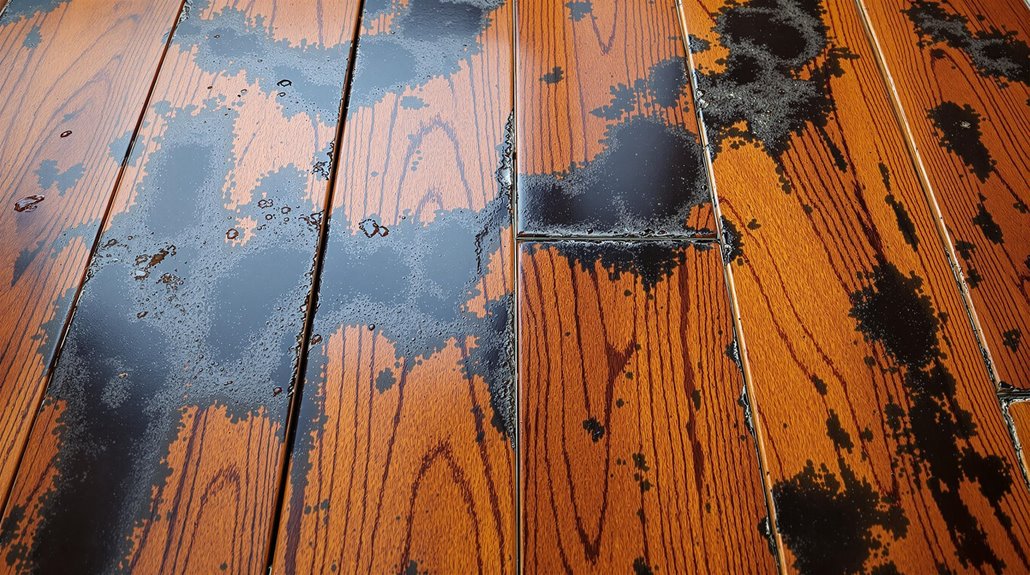
Early signs of water damage in hardwood floors manifest through visible discoloration, including dark spots and staining between planks where moisture has penetrated beneath the finish.
Warping occurs when floorboards absorb excess water, causing them to distort and potentially separate from the subfloor. Trapped moisture can lead to the growth of hazardous mold within 24 hours of water exposure.
Cupping, a specific form of warping, presents as elevated edges with a lower center across affected boards, indicating trapped moisture beneath the surface.
Discoloration and Dark Spots
Dark spots and discoloration in hardwood flooring serve as essential indicators of water damage that require immediate attention.
These manifestations occur when wood absorbs moisture, leading to mineral deposits and salt stains that compromise the floor's integrity. Discoloration causes range from direct water exposure to elevated humidity levels, presenting as dark patches, white streaks, or distinctive rings. The absorption process often leads to softening and expansion of wooden planks, further compromising structural stability.
Understanding dark spots prevention requires regular monitoring and swift action. Professionals utilize moisture meters to assess damage severity and determine appropriate remediation strategies.
Different wood species exhibit varying resistance to moisture damage, influencing the extent of discoloration. When left untreated, these issues can escalate to severe structural problems, mold growth, and costly repairs.
Early detection through systematic inspection, coupled with immediate professional intervention, remains vital for preserving hardwood flooring integrity.
Boards Warping and Cupping
Beyond visible discoloration, water damage in hardwood floors often manifests through structural deformation, specifically warping and cupping of individual boards.
These distortions typically present as raised edges with concave centers, creating a distinctive wave-like pattern across flooring materials.
The primary culprits behind warping and cupping include seasonal humidity fluctuations, subfloor moisture penetration, and localized water exposure from spills or leaks.
Effective moisture management is essential, as boards can develop gaps, crowning, or even complete buckling when exposed to excessive moisture.
Professional assessment becomes necessary when boards lift from the subfloor or show severe deformation.
Prevention strategies include maintaining consistent indoor humidity levels, proper installation techniques, and immediate response to water exposure.
Regular moisture monitoring and appropriate cleaning methods help preserve the floor's structural integrity.
Essential Steps for Emergency Water Removal
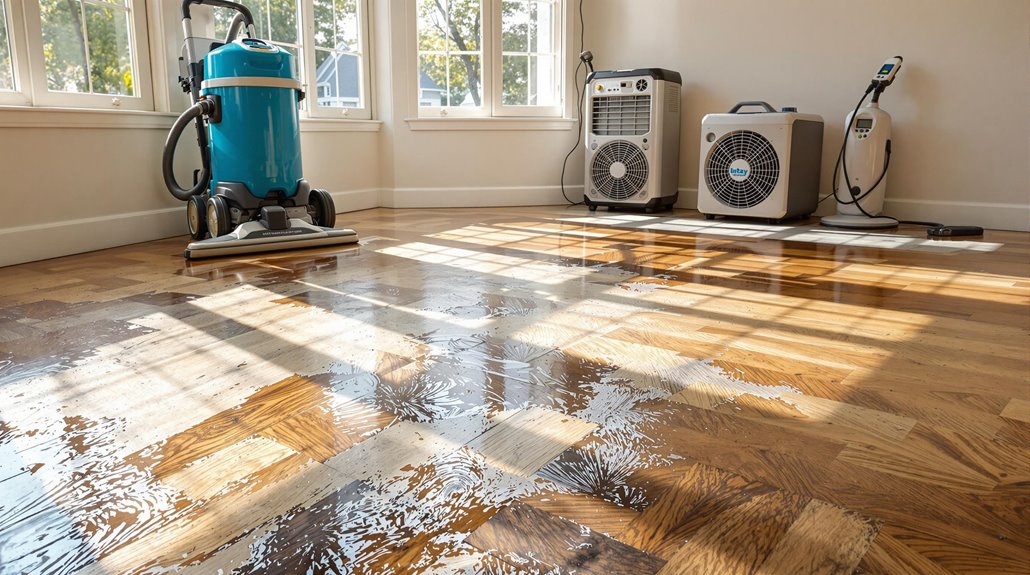
Swift action during water emergencies can prevent extensive damage to wood flooring. Implementing proper water extraction techniques begins with removing standing water using wet/dry vacuums or absorbent materials, working methodically from the edges toward the center to prevent further spread.
Emergency response strategies must include thorough cleaning and disinfection of the affected area to prevent mold growth.
After initial cleanup, establishing proper ventilation becomes essential. The deployment of fans and dehumidifiers accelerates the drying process, while moisture meters help monitor progress until the floor reaches appropriate moisture levels.
To prevent recurring issues, identify and repair water sources immediately.
Regular inspection of both the hardwood flooring and subfloor guarantees early detection of potential problems, while maintaining proper humidity levels helps preserve the floor's integrity.
Professional vs. DIY Water Damage Repair
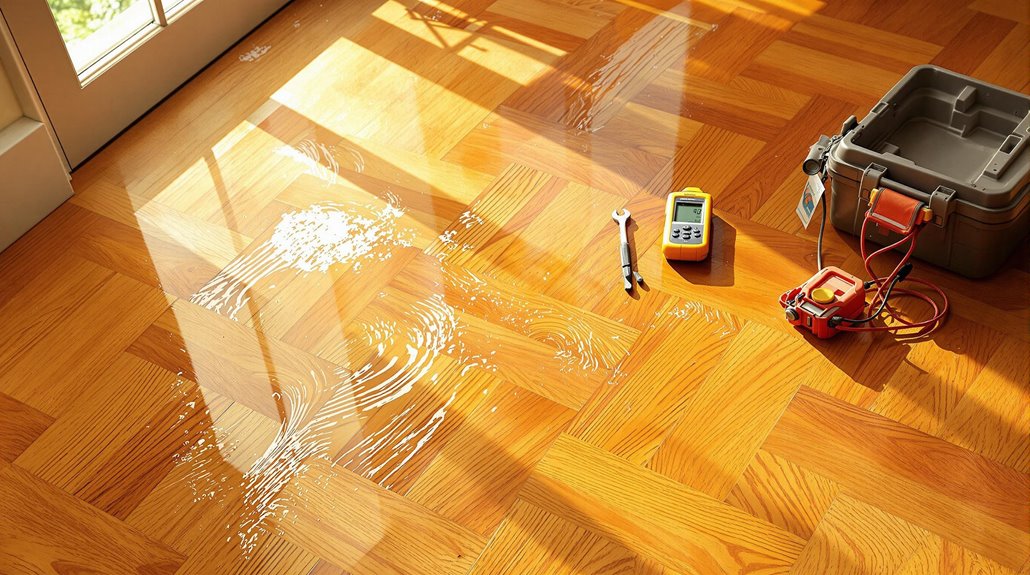
When evaluating whether to hire professionals or attempt DIY water damage repair, homeowners must analyze both immediate costs and long-term financial implications.
The skill requirements for proper water damage restoration include expertise in moisture detection, mold remediation, and specialized drying techniques that typically exceed DIY capabilities.
Professional services, while initially more expensive, often prove more cost-effective by preventing secondary damage and providing thorough documentation for insurance claims.
Working with licensed public adjusters can help maximize insurance settlements for water damage claims, with studies showing significantly higher payouts compared to handling claims independently.
Cost-Benefit Analysis Breakdown
Although repairing water-damaged wood floors presents homeowners with the choice between professional and DIY approaches, a detailed cost-benefit analysis reveals considerable differences in both immediate expenses and long-term outcomes.
When evaluating repair strategies, consider these critical factors:
- Professional services average $2-$20 per square foot for standard repairs, while DIY material costs vary considerably and may require equipment rental.
- Professional repairs include specialized water extraction equipment and expert assessment, valued at $500-$1,500 per project.
- Insurance coverage typically favors professional repairs, potentially offsetting $10-$80 per square foot in water damage costs.
- Long-term value assessment shows professional repairs offer warranties and reduce the risk of subsequent damage, while DIY methods may require costly professional intervention later.
Similar to roof damage claims, thorough damage documentation with photographs and detailed descriptions significantly impacts insurance settlement amounts for water-damaged floors.
Skill Requirements Assessment
Successful water damage repair requires a broad understanding of both professional expertise and DIY capabilities to determine the most effective approach. Varying skill levels dictate the feasibility of repairs, with professional technicians possessing specialized repair tools and training for thorough damage assessment and remediation.
Professional restoration experts utilize advanced drying equipment, moisture meters, and industrial-grade dehumidifiers to guarantee complete water extraction and prevention of secondary damage.
DIY repairs, while suitable for minor incidents, demand basic competency in damage assessment, proper drying techniques, and safety protocols. The complexity of water damage often necessitates professional intervention, particularly when dealing with hidden moisture, potential mold growth, or structural concerns.
Critical evaluation of one's technical abilities, available resources, and the extent of damage should guide the decision between professional and DIY restoration methods.
The Complete Cost Breakdown for Floor Restoration
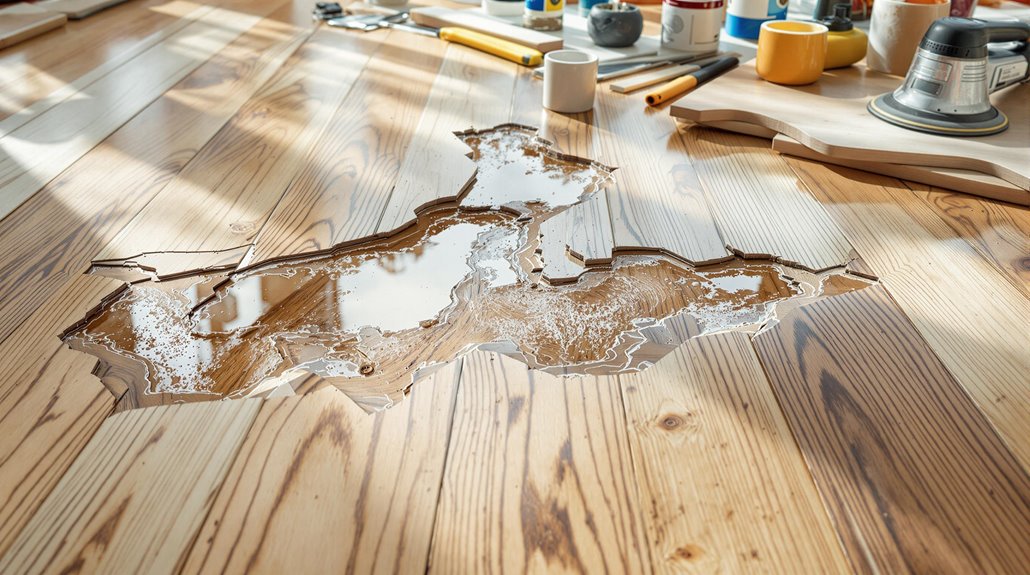
The investment required for water-damaged floor restoration varies considerably based on multiple factors, ranging from $1,101 to $2,666 for basic refinishing projects and potentially exceeding $15,000 for complete replacements.
Professional floor restoration costs are influenced by room dimensions, wood type, and damage severity, with larger spaces commanding higher expenses.
Key cost factors include:
- Square footage rates: $3-8 for traditional refinishing, up to $11.15 for specialized methods
- Labor variations: $200-800 for 100 sq ft, up to $16,000 for 2,000 sq ft spaces
- Wood selection: Bamboo ($2-6/sq ft) vs. Mahogany ($6-8/sq ft)
- Treatment method: Minor repairs ($3-7/sq ft) vs. board replacement ($8-30/sq ft)
Professional assessment remains essential for determining the most cost-effective restoration approach while ensuring ideal results.
Effective Drying Methods and Equipment
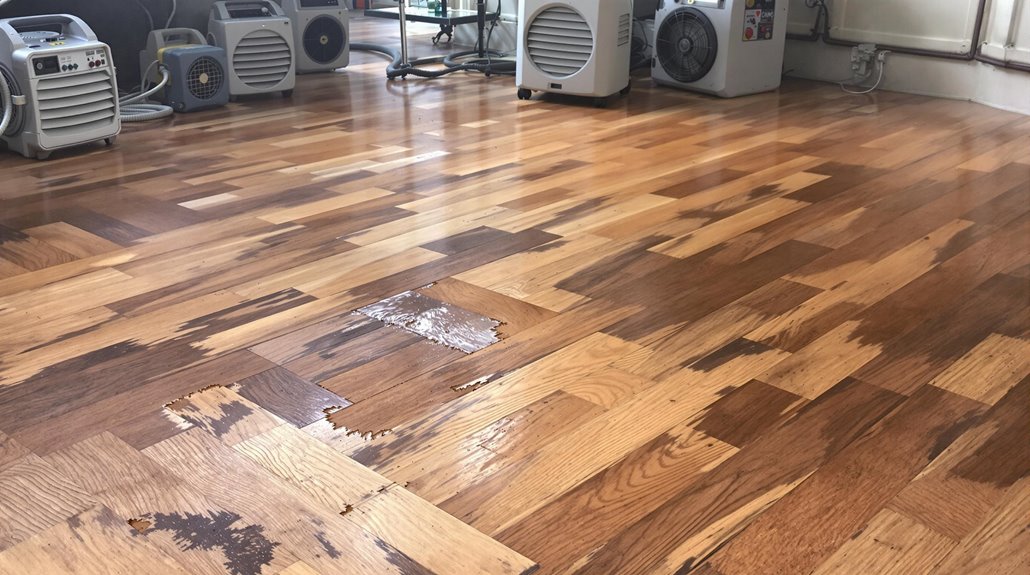
Proper drying methods and equipment selection represent critical factors in preventing permanent damage to water-affected hardwood floors.
Professional moisture detection equipment, including penetrating meters and advanced monitoring systems, enables precise identification of affected areas and tracking of drying progress.
Essential drying techniques incorporate multiple specialized tools working in concert.
Industrial dehumidifiers reduce ambient moisture while strategically placed air movers optimize airflow patterns.
The Injectidry system creates negative pressure to extract subsurface moisture, while panel floor drying systems provide controlled environmental conditions.
Heat drying systems, when properly contained and monitored, can accelerate the process.
For maximum effectiveness, the drying area should be sealed with 6-mil poly sheeting, and indoor conditions must be strictly controlled to prevent additional moisture introduction through vapor pressure differentials.
Long-Term Impact of Water on Wood Flooring
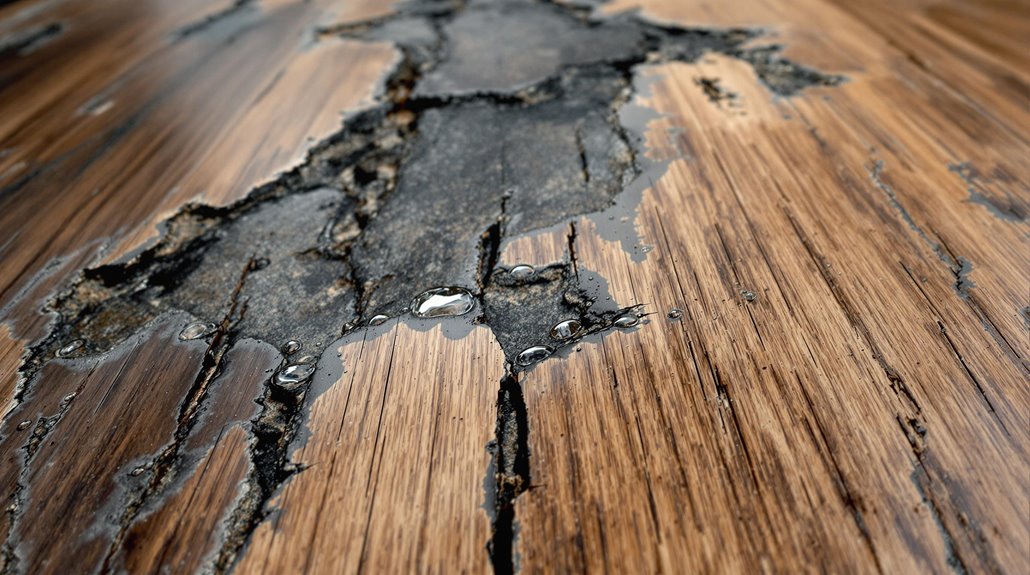
Prolonged water exposure degrades wood flooring's structural integrity through progressive deterioration of both surface boards and supporting subfloor components.
The compromised materials create favorable conditions for mold proliferation and bacterial growth, introducing respiratory hazards and potential toxin exposure to occupants.
Beyond the immediate physical damage, untreated water-damaged wood flooring greatly diminishes property market value and may necessitate complete system replacement to restore both safety and aesthetics.
Structural Integrity Over Time
Water infiltration poses a significant threat to wood flooring systems, initiating a cascade of deteriorating effects that compromise structural integrity over time.
Regular structural assessment becomes vital as moisture penetration triggers multiple degradation mechanisms within the flooring components.
The progression of water damage typically follows this pattern:
- Wood fibers absorb moisture, leading to warping and dimensional changes
- Adhesive bonds between flooring layers weaken, causing delamination
- Subfloor deterioration begins, undermining the foundational support
- Mold growth accelerates structural breakdown of wood components
Effective moisture control measures are essential to prevent these cumulative effects.
Without intervention, the compromised integrity can result in complete system failure, necessitating extensive repairs or full replacement of both flooring and subfloor materials.
Hidden Health Hazards Emerge
A concerning array of health hazards develops when moisture infiltrates wood flooring systems, creating an environment conducive to microbial growth and deterioration.
Within 24-48 hours of water exposure, mold spores begin colonizing affected areas, releasing potentially harmful compounds into the indoor air environment.
The respiratory health impacts can be particularly severe for vulnerable populations, including children, elderly individuals, and those with compromised immune systems.
Occupants may experience allergic reactions, respiratory difficulties, and other health complications from prolonged exposure.
Effective mold prevention strategies include immediate moisture removal, proper ventilation, and professional remediation when necessary.
Even after visible water damage is addressed, hidden moisture pockets can continue supporting microbial growth, necessitating thorough inspection and treatment of affected areas to guarantee occupant safety.
Property Value Takes Hit
The devastating financial impact of water-damaged wood flooring extends far beyond immediate repair costs, considerably diminishing overall property values and market appeal.
Current market trends indicate significant property depreciation when water damage compromises wood flooring integrity, particularly affecting structural components and aesthetic appeal.
Professional assessors identify four essential value-diminishing factors:
- Structural deterioration of subflooring and support systems
- Visible surface damage including warping, buckling, and discoloration
- Potential development of hazardous mold conditions
- Long-term maintenance concerns affecting future marketability
Early intervention remains vital for value preservation.
Properties with documented water damage history often face extended market listing periods and reduced buyer interest, necessitating substantial price reductions.
Professional restoration services, while initially costly, prove instrumental in maintaining property values and preventing further depreciation.
Homeowners insurance provides crucial protection against sudden and accidental water damage, helping preserve property values when water-related disasters strike.
Best Practices for Preventing Future Damage
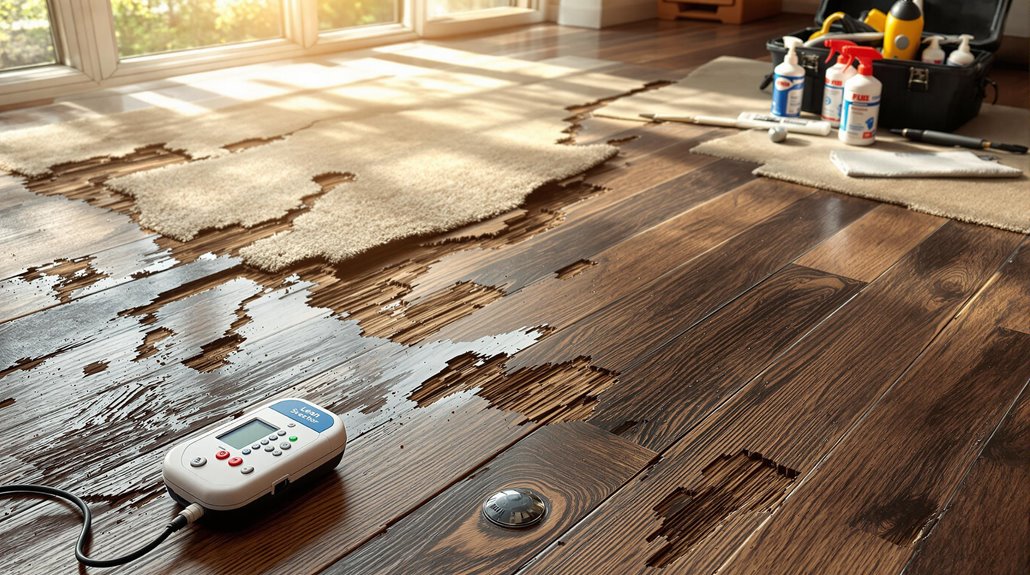
Preventing water damage to wood floors requires an extensive, multi-layered approach that combines regular maintenance, protective measures, and early detection systems.
Thorough water safety protocols include installing leak detection devices, conducting routine plumbing inspections, and addressing vulnerabilities in roofs and walls promptly.
Essential flooring maintenance practices involve applying water-resistant finishes, periodic sealing of hardwood surfaces, and strategic placement of protective rugs and mats in high-risk areas.
Property owners should guarantee proper ventilation systems are in place to minimize moisture accumulation.
Installing moisture barriers and maintaining adequate drainage systems further safeguards wood floors from water exposure.
Regular professional inspections can identify potential issues before they escalate into significant problems, while documenting all maintenance activities helps track the effectiveness of preventive measures.
Insurance Coverage for Water-Damaged Floors
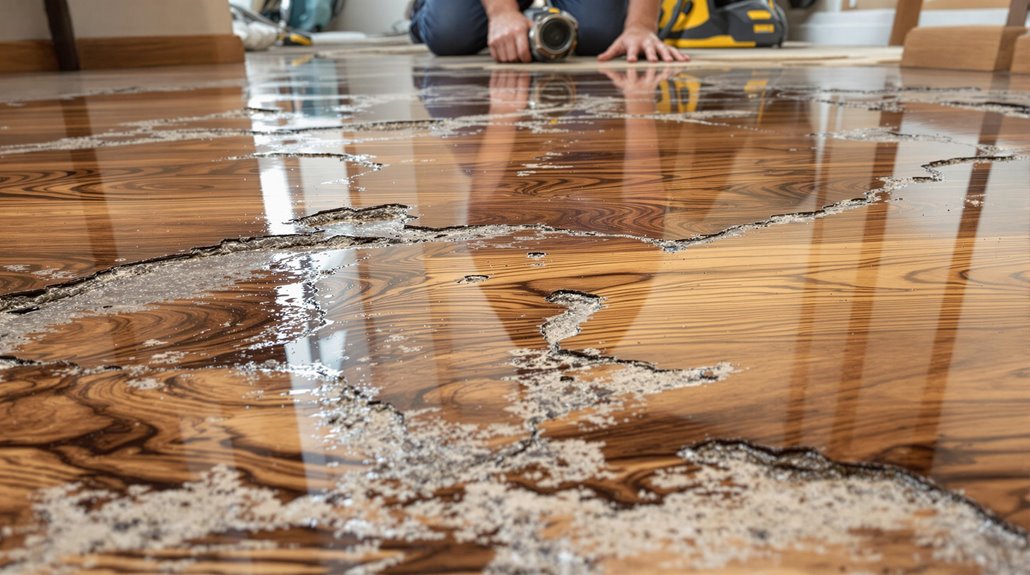
When water damage occurs to wood flooring, insurance coverage typically depends on the specific cause of damage and policy provisions in place. Homeowners insurance policies generally cover sudden and accidental water damage, but exclude flooding and long-term seepage issues.
Key aspects of insurance coverage for water-damaged floors include:
- Dwelling coverage applies to repair or replacement costs for damage from covered perils like burst pipes.
- Documentation through photos and detailed notes is essential for claim approval.
- Insurance policy coverage limits and deductibles determine final payout amounts.
- Emergency drying services are typically covered to prevent additional damage.
For successful claims, property owners should contact their insurance provider immediately, prevent further damage, and work with recommended restoration professionals within the approved coverage limits. Regular policy reviews help ensure homeowners maintain adequate coverage for potential water damage scenarios.
When to Replace vs. Repair Wet Wood Floors
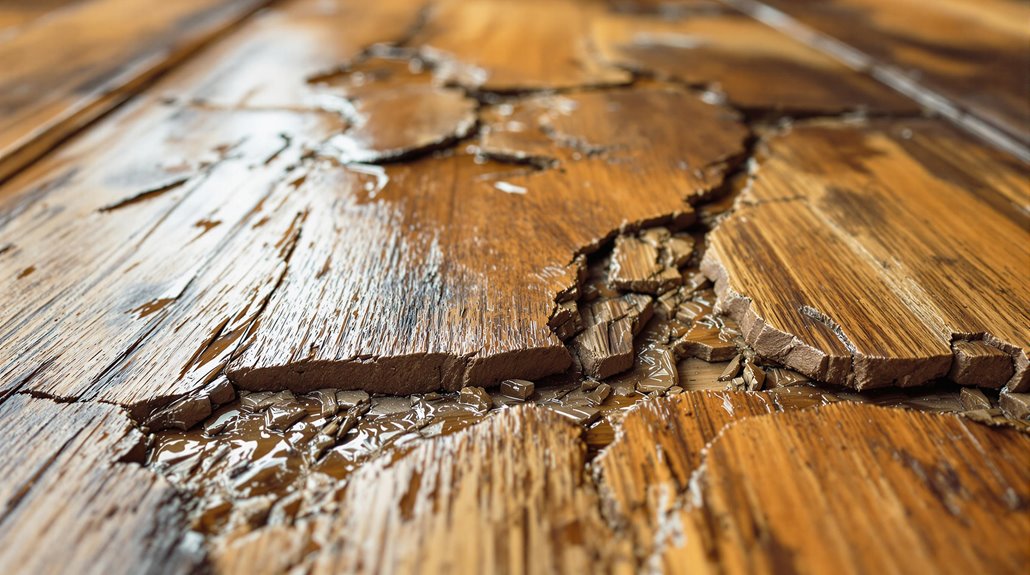
Determining whether to replace or repair water-damaged wood floors requires careful assessment of multiple factors, including the extent of water exposure, type of damage, and presence of mold.
Replacement considerations become necessary when floors exhibit severe buckling, cupping, or structural instability, particularly when water has penetrated the subfloor. Musty odors and extensive mold growth typically indicate replacement is the safer option.
Repair strategies may be sufficient for minor water damage when addressed promptly.
Professional intervention is recommended for large-scale damage, contaminated water exposure, or compromised subflooring. While DIY repairs might be feasible for small areas with surface-level damage, substantial restoration often requires professional expertise, especially when structural integrity is compromised or specialized equipment is needed for proper drying and refinishing.
The Benefits Of Consulting A Public Adjuster

Professional public adjusters provide specialized expertise in guiding complex water damage insurance claims for wood flooring, offering objective damage assessments and detailed documentation that insurance companies require.
Their industry knowledge and negotiation skills typically result in considerably higher claim settlements, with studies showing settlements up to 747% greater than claims filed without professional representation.
Public adjusters manage the entire claims process, from initial documentation through final settlement, allowing property owners to focus on restoration while ensuring maximum coverage under their policy terms.
Operating on a contingency fee basis, public adjusters typically charge 5-20% of the final settlement amount, making their services accessible to property owners dealing with water-damaged floors.
Expertise In Insurance Claims
A public adjuster's expertise in insurance claims can greatly impact the outcome of water-damaged wood floor cases. Their advanced knowledge of claim strategies and policy interpretation guarantees thorough coverage assessment while maneuvering complex insurance procedures.
Professional adjusters employ systematic approaches to maximize claim settlements through:
- Detailed documentation of water damage extent, including moisture readings and photographic evidence
- Thorough assessment of both visible and hidden damage to wood flooring systems
- Precise interpretation of policy coverage, exclusions, and endorsements
- Strategic negotiation with insurance carriers to secure fair compensation
Working on a contingency fee basis, public adjusters meticulously prepare and present claims, leveraging their understanding of industry standards and insurance company tactics.
Their expertise proves particularly valuable in complex water damage scenarios where proper documentation and technical knowledge are essential for ideal settlement outcomes.
Objective Damage Assessment
Thorough damage assessment by public adjusters delivers crucial insights beyond surface-level observations of water-damaged wood floors.
Using advanced diagnostic tools, including moisture meters and thermal imaging equipment, adjusters conduct detailed damage evaluation to identify hidden issues that might otherwise go undetected. This systematic approach reveals structural vulnerabilities and potential mold growth beneath visible surfaces.
Professional moisture detection encompasses detailed documentation of all findings, creating an essential record for insurance claims.
Public adjusters meticulously assess both primary water damage and secondary effects, determining accurate repair costs and timelines. Their specialized knowledge of wood properties and restoration techniques guarantees every aspect of the damage is properly evaluated and documented.
This thorough assessment forms the foundation for securing appropriate compensation through the claims process.
Streamlined Claim Process
Public adjusters greatly streamline the insurance claims process for water-damaged wood floors by managing complex documentation requirements and intricate policy interpretations.
Their professional claim assistance guarantees thorough coverage while minimizing delays and potential claim denials.
Key benefits of documentation management through a public adjuster include:
- Expedited processing through systematic organization of damage evidence, repair estimates, and policy documentation
- Expert navigation of insurance policy terms to maximize coverage for wood floor water damage
- Professional representation during negotiations to secure fair compensation for repairs
- Reduced stress by managing all communication channels between contractors, insurance companies, and property owners
This streamlined approach allows property owners to focus on restoration while guaranteeing their claim receives proper attention and fair settlement.
Higher Claim Payouts & Settlements
The retention of a public adjuster greatly increases the likelihood of securing higher insurance claim settlements for water-damaged wood floors.
Through thorough policy evaluation and expert claim negotiation, these licensed professionals guarantee maximum coverage utilization while identifying all compensable damages.
Public adjusters employ specialized training to document both visible and hidden water damage to wood flooring, often discovering issues that might otherwise go unnoticed.
Their contingency-based fee structure aligns their interests with maximizing the policyholder's settlement.
Operating with technical precision, they compile detailed documentation, expert assessments, and supporting evidence to substantiate larger claims.
Their systematic approach to damage evaluation, combined with extensive knowledge of insurance procedures, typically results in settlements that considerably exceed those obtained by policyholders acting independently.
About The Public Claims Adjusters Network (PCAN)
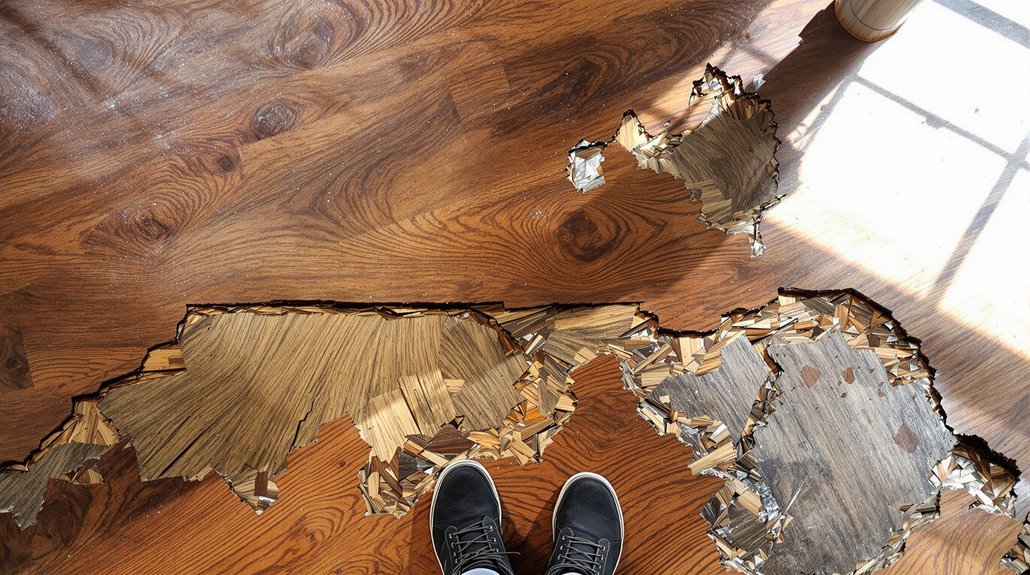
Professional claims adjusters unite under PCAN to provide extensive policyholder advocacy services nationwide. This network of licensed experts delivers thorough claims handling solutions with decades of combined experience in property damage assessment and settlement negotiations.
Key aspects of PCAN's claims advocacy include:
- Independent representation guaranteeing unbiased evaluation and documentation of water-damaged wood flooring claims
- Expert policy interpretation and validation services across all 50 states
- Streamlined communication channels between policyholders, insurers, and repair specialists
- Customized solutions tailored to each property's unique damage circumstances
The public adjuster benefits through PCAN extend beyond basic claims processing, offering specialized knowledge in construction and repair requirements while maintaining transparent client communication throughout the settlement process.
Their international reach guarantees thorough support for complex claims requiring global expertise.
Frequently Asked Questions
How Long Can Hardwood Floors Remain Underwater Before Becoming Permanently Damaged?
Hardwood flooring longevity greatly diminishes after 24-48 hours of water saturation, with permanent structural damage and mold growth becoming prevalent beyond this critical timeframe, necessitating immediate professional intervention.
Can Water-Damaged Wood Floors Be Saved if They've Developed Mold Underneath?
When push comes to shove, water-damaged wood floors with mold can be salvaged through professional mold remediation and floor restoration, provided structural integrity remains intact and treatment begins promptly.
Will Homeowners Insurance Cover Pre-Existing Water Damage to Wood Floors?
Insurance policies specifically exclude pre-existing water damage from coverage. Standard policy terms require water damage to be sudden and accidental, with documented proof of when damage occurred.
What Temperature Should I Maintain to Prevent Moisture Damage in Wood Floors?
While many focus solely on temperature, ideal wood floor protection requires maintaining 18-23°C alongside 35-55% humidity levels. This ideal temperature range prevents moisture-related expansion and contraction that causes damage.
Can Steam Cleaning or Wet Mopping Damage Hardwood Floors Over Time?
Steam cleaning effects and improper mopping techniques can severely damage hardwood floors, causing warping, discoloration, and structural deterioration through excessive moisture penetration and breakdown of protective finishes over time.
References
- https://tottahardwoods.com/repairing-a-water-damaged-hardwood-floor/
- https://jenkinsrestorations.com/how-to-minimize-and-repair-water-damage-to-wood-floors/
- https://www.keystonestaterestoration.com/post/how-to-repair-water-damaged-wood-floor
- https://www.cleanerguys.com/can-water-damage-wood-floor/
- https://www.alldryus.com/blog/water/water-damaged-wood-floors/
- https://www.carpettech.com/blog/wood-floor-water-damage/
- https://www.steamyconcepts.com/blog/2023/09/01/water-damage-on-wood-floors-types-of-damage-restoration/
- https://superiorrestore.com/wood-floor-water-damage-cause-effect-solution/
- https://www.powerdrykc.com/blog/signs-that-your-hardwood-floors-are-water-damaged/
- https://preferred-flooring.com/blog/4-signs-your-wood-floor-has-water-damage/
